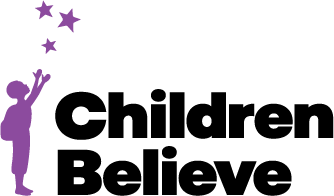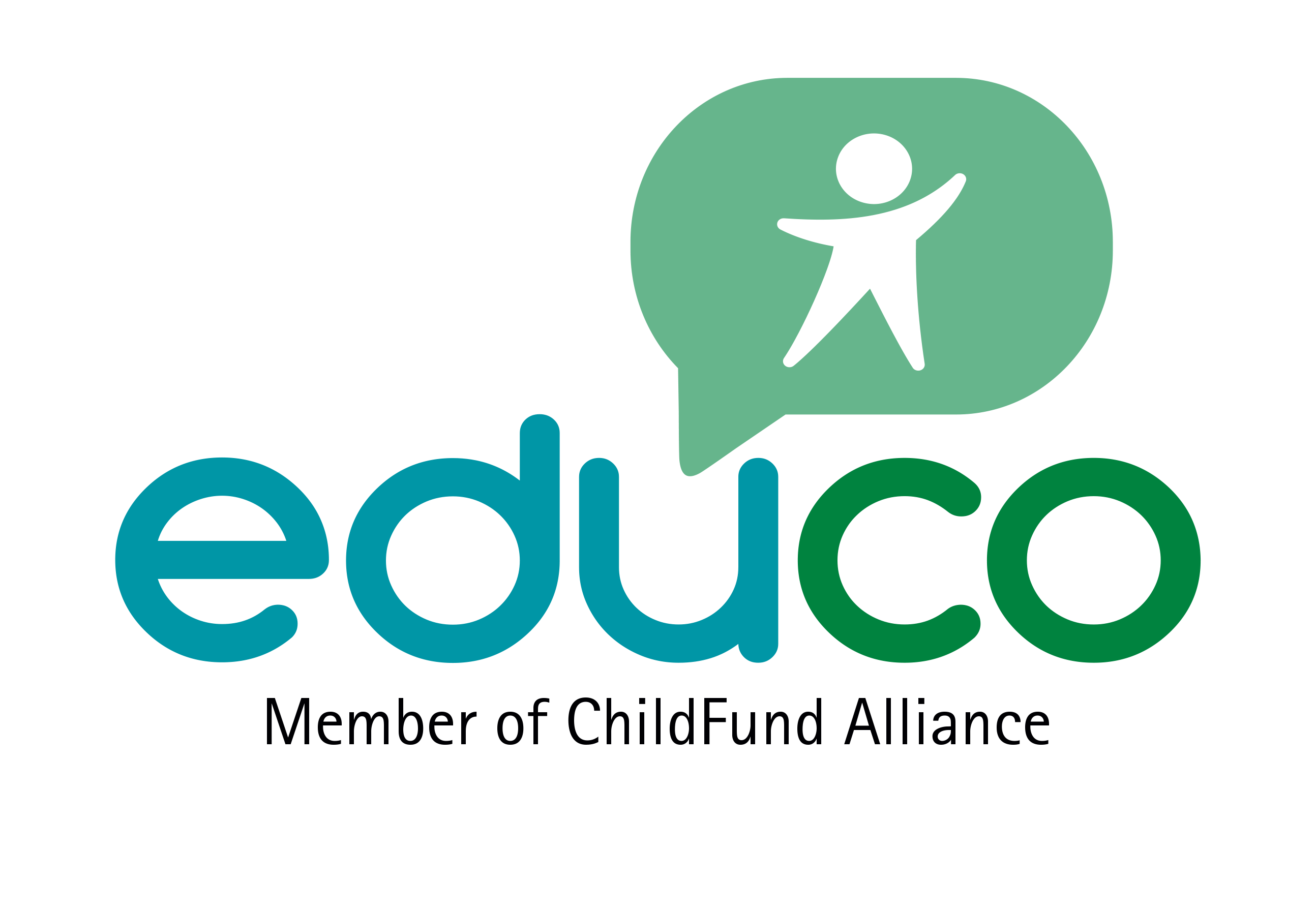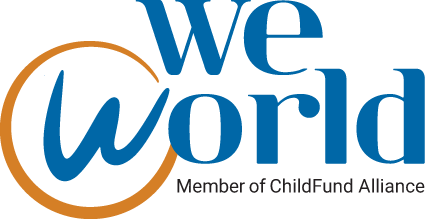ChildFund Deutschland's Critical Work in Ukraine: An Agonizing Choice for Displaced Mothers
- by Joern Ziegler, Managing Director, ChildFund Deutschland
- / Member Spotlight
Since 2004, ChildFund Deutschland (Germany) has been working on behalf of children and youth in Ukraine with two partners, Child Wellbeing Fund Ukraine and the East Europe Foundation.
In 2014, it began providing humanitarian emergency response for internally displaced families and children (IDPs). Today, ChildFund is collaborating with more than half a dozen partner organizations in Ukraine.
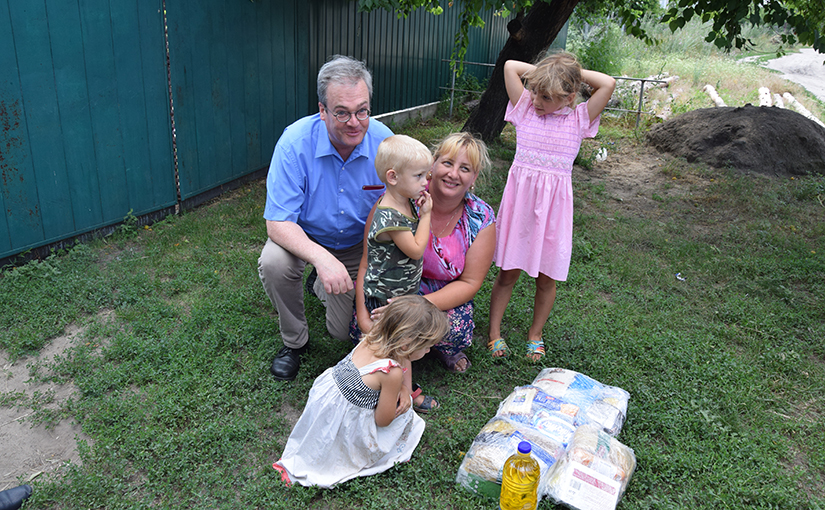 Joern Ziegler, Managing Director of ChildFund Deutschland, meets with a family living in a camp for internally displaced people that is supported by the German development agency GIZ (German Corporation for International Cooperation). ChildFund offers various activities for the children who are living in very difficult conditions here. © Yellow-Blue Wings
Joern Ziegler, Managing Director of ChildFund Deutschland, meets with a family living in a camp for internally displaced people that is supported by the German development agency GIZ (German Corporation for International Cooperation). ChildFund offers various activities for the children who are living in very difficult conditions here. © Yellow-Blue Wings
ChildFund received a grant from the German Ministry for Economic Cooperation and Development (BMZ) for protecting and supporting displaced children and youth, and promoting social entrepreneurship as a way to improve the income of IDPs. A grant from the German Foreign Office (AA) supports youth initiatives in the Ukrainian civil society.
ChildFund is also implementing projects that focus on health and peace-building. These projects, funded by individual donors, are spread throughout the country.
In July 2017, Joern Ziegler, Managing Director of ChildFund Deutschland, went to eastern Ukraine to monitor some of these programs and to visit some of their partner organizations. Here he reflects on his first visit to Ukraine since February 2015.
Day One: The Art of Mediation
A one-hour flight took me from the capital Kiev to Kharkiv, the second biggest city of Ukraine and one of the hot spots for working with IDPs. There I attended a one-day conference on mediation and peace building. Mediation – be it in the legal system, at schools or in resolving conflicts between different sections of the population – is a new technique for Ukraine.
Nearly 100 teachers, NGO activists and representatives of local and regional governments attended the conference. Many had travelled long distances and paid their own way, underlining their commitment to the topic.
Experts from Moldova, Georgia, Germany and Ukraine itself presented and worked with the participants. I was impressed by the level of interest, enthusiasm and active participation. I was especially impressed by Danilo, a 16-year-old student from Slovyansk, a city close to the occupied territory. He came by own initiative and at his own expense to learn more about ways to mediate between young people belonging to different segments of the population.
Day Two: Harsh Conditions in IDP Camps
We visited a camp for IDPs established by the German governmental agency GIZ in 2015. Some 300 IDPs, most of them women, children and elderly people, are still living here in portacabins (small portable huts). The inhabitants have very limited space, with two families often sharing one room. These portacabins were supposed to be used for one year; now in the second year, some roofs are starting to leak. We heard heartbreaking stories from some of the people about their background and about their attempts to find work to allow them to pay the rent for a flat (apartment). Some of them had failed and had to return to the portacabins, a rather demotivating step.
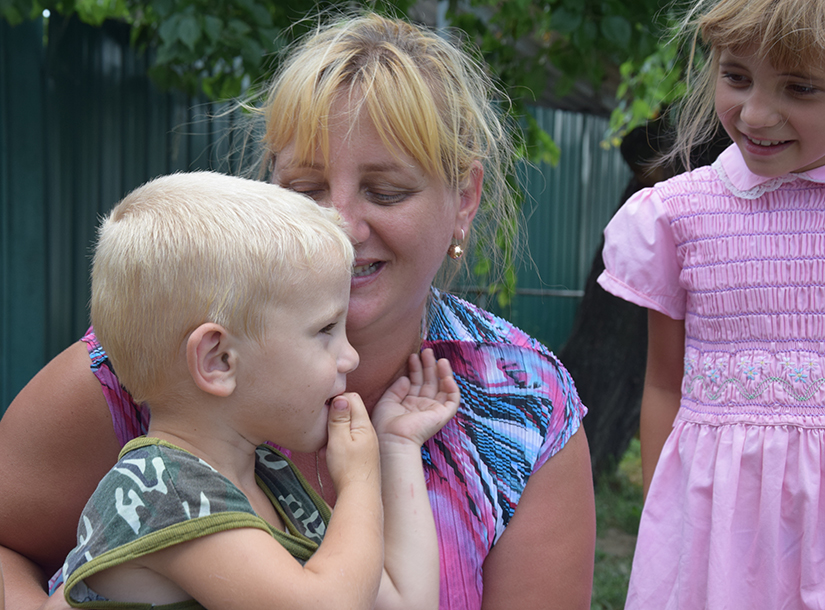 Conditions are difficult for the displaced families living in this IDP camp. Most are women, children and elderly people, living in cramped conditions. This mother of five tries to survive from what she grows in their garden. They are living in the so-called gray zone, which is occasionally affected by fighting. © Yellow-Blue Wings
Conditions are difficult for the displaced families living in this IDP camp. Most are women, children and elderly people, living in cramped conditions. This mother of five tries to survive from what she grows in their garden. They are living in the so-called gray zone, which is occasionally affected by fighting. © Yellow-Blue Wings
The camp has no trees and no shade, leaving people exposed to the hot Ukrainian sun. The summer heat is uncomfortable, but at least doesn’t cost the IDPs money. The big problem is the winter, when IDPs have to pay up to 80 percent of their monthly state support just for electricity, the only form of heating. Some mothers told us that in the winter they have to decide whether the children should stay cold or stay hungry. ChildFund has supported children in this camp for some time: two rooms are reserved for activities with children when the project worker visits the camp (usually twice a week).
Next, we visited the Kharkiv children´s center, which is funded by BMZ, where we spoke with staff and children. Most of the current activity is dealing with psychosocial problems and post-traumatic stress. The majority of the children using the center are IDP children; a minority, however, comes from the local population in Kharkiv.
In the afternoon we drove to Sieverodonetsk, the interim capital of the district of Luhansk. Luhansk is occupied by so-called separatists and is not under government control. The roads got worse and worse the farther east we travelled; it took us nearly five hours to travel 250 kilometers. Occasional police checkpoints indicated a tenser situation. The German government recommends that people don’t visit Sieverodonetsk for security reasons. In the evening, we explored the almost deserted city; there were very few cars or people in the streets.
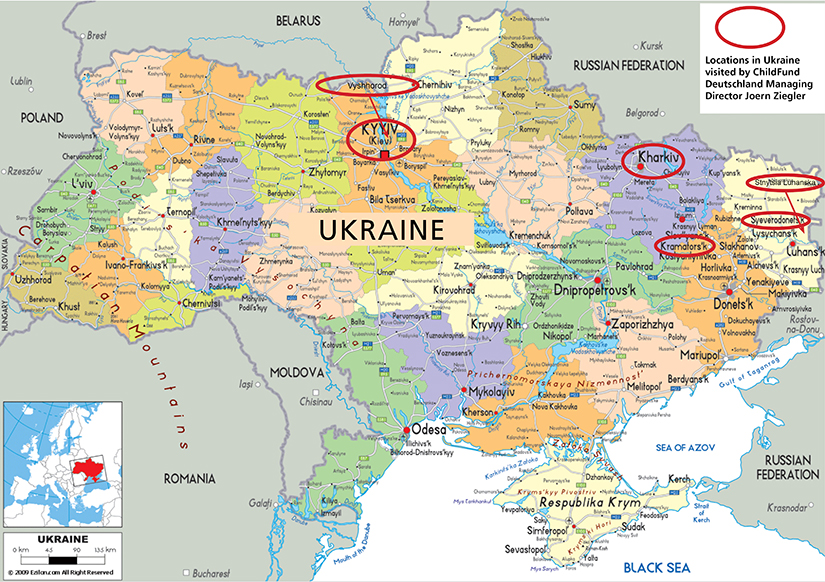
Day Three: Living on the Front Line
Before leaving Sieverodonetsk, we were joined by two officers of CIMIC, a part of the Armed Forces of Ukraine. Without these officers, we would not have been able to get through the many checkpoints and controls on our way to Stanytsia Luhanska, a small town of 14,000 people located directly on the front line between government- and separatist-controlled areas. The CIMIC officers knew the passwords which are changed each hour.
Stanytsia Luhanska is in the so-called “Gray Area.” In the city and the region, occasional fighting and shelling regularly kill people. We saw shooting holes in many buildings, and we passed burned areas in the pine forest where shells or rockets had landed.
A number of individuals in and around this city are recipients of ChildFund´s humanitarian program. We visited a grandmother taking care of her eight-year-old granddaughter who has a disability; an IDP family of three generations who cannot return to their home in Luhansk and have to live in their small summer house; and a family with five young children trying to survive on what they grow in their garden.
One of the two schools in Stanytsia Luhanska has been completely destroyed by shelling; the other one – which we visited – was damaged, but has been repaired.
 In Stanytsia Luhanska, a small town near the frontline, we met with the head of the regional administration (in blue shirt). © Yellow-Blue Wings
In Stanytsia Luhanska, a small town near the frontline, we met with the head of the regional administration (in blue shirt). © Yellow-Blue Wings
We met the head of the regional administration, who told us that one of biggest problems the city faces – apart from occasional shooting – is that the population is cut off from the previous regional center, the city of Luhansk. Travelling to a hospital now means a car drive of three hours on bad roads – often impossible for sick or poor people.
Before driving back to Sieverodonetsk in the late afternoon, we walked through the city, avoiding the places where long-distance snipers sometimes shoot people, and observed the activity around the checkpoint. Pedestrians can cross the front line here in both directions, but it is an arduous procedure, with a 2.5-kilometer walk through no man´s land. Some time ago, a Ukrainian soldier who had helped a person in a wheelchair through the no man´s land was captured by so-called separatist forces; the soldier is still missing.
Day Four: From Play Groups to “Green Men”
Here in Sieverodonetsk, ChildFund has another children´s center as part of the BMZ program. We had a two-hour meeting with staff, children, parents and two representatives of the city administration. The center offers varied activities for children of all ages, including play groups for children aged under six, and psychosocial rehabilitation and various courses for both children and parents. Freshly painted rooms offer a friendly and open atmosphere. The children, youth and parents making use of the center´s opportunities are both IDPs and local Sieverodonetsk residents. The center is led by Victor, a very committed young man in his late twenties – he himself is an IDP from Luhansk.
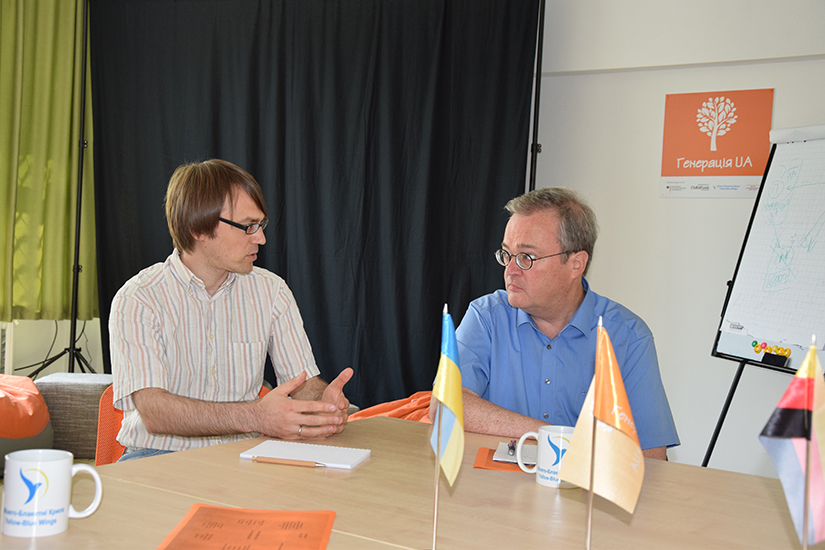 In Sievierodonetsk, the rehabilitation center for IDP children, which is based in an apartment, is led by Victor, himself an IDP from Luhansk. © Yellow-Blue Wings
In Sievierodonetsk, the rehabilitation center for IDP children, which is based in an apartment, is led by Victor, himself an IDP from Luhansk. © Yellow-Blue Wings
In the afternoon, we continued by car to Kramatorsk, the interim capital of the district of Donetsk. Donetsk is occupied territory, and notorious for the heavy fighting around the city and its airport. Despite the bad roads and checkpoints and controls at every intersection, we covered the 100 kilometers in little more than two hours.
Kramatorsk reminded me of Sieverodonetsk, but with even fewer cars and fewer people in the streets.
Day Five: ChildFund-supported Young Entrepreneurs
In Kramatorsk we visited the NGO “Country of free people,” led by Nadia Chomenko, which does a lot of important work for children. We met this NGO since we are considering establishing another ChildFund children´s center here, and having a reliable NGO partner with a proven record in running good projects would be a big advantage.
Kramatorsk faces the same problems as other cities close to the Gray Area – poverty, limited economic activity, a poor health system and not enough medical staff, damaged infrastructure and transport facilities, divided families and children suffering from post-traumatic stress.
We next visited the Kramatorsk innovation platform “Free Hut,” a social entrepreneurial initiative which is giving work and income to a number of young people. ChildFund´s BMZ-funded program for social entrepreneurship is collaborating with the “Free Hut” activists. We learned about a recent training on social entrepreneurship, which was part of ChildFund´s program. Five of the 20 young participants presented some promising business ideas and concepts at the end of the training. In a second phase, the program will try to support these young people in realizing their ideas and getting their social business started. They presented us the first book published in Ukraine about social entrepreneurship, which was published as part of ChildFund´s program.
In the late afternoon, we took the train from Kramatorsk to Kiev. A rather modern express train brought us back to the capital in six hours. What a difference! A city full of people, cars, noise and activities – after the deserted Eastern cities a radical change. The travel itself was enjoyable – lots of beautiful countryside with many blooming sunflower fields under a very blue sky. It is said the blue-yellow of the Ukrainian flag stems from these colors of sky and sunflowers.
Day Six: Advocacy in the Capital
A working day in the capital. We had a meeting in the German Embassy, where we exchanged information about the situation in the Eastern regions of Ukraine, the need to do more in support of people living in poverty, the challenges and difficulties encountered when working in Ukraine, and some practical steps for a better networking among NGOs and German as well as Ukrainian officials. The Embassy representatives were astonished and perhaps even a bit shocked that I had visited exactly those regions which they strongly recommend people not to visit. But how can we help children and other people in need if we give absolute priority to our way of “securing security”?
Finally, we had a meeting with a representative of the German government agency GIZ which is involved in a number of sectors in Ukraine. An exchange with GIZ is always useful – the agency has a lot of experience in certain areas.
Day Seven: Help for Children with Disabilities
On my last travel day, we went to Vyshhorod, a small town some 20 kilometers outside of Kiev. In this region, ChildFund does a lot for children with disabilities – both individually and through a special school. We first visited some of these families in their homes, taking a look at their living realities and hearing about how they manage daily life.
Ukraine doesn’t provide support for citizens with disabilities, who still live very much under post-Soviet conditions. If nongovernmental initiatives didn’t do something for children with disabilities, many of them would not have a chance to have a social life or even attend school.
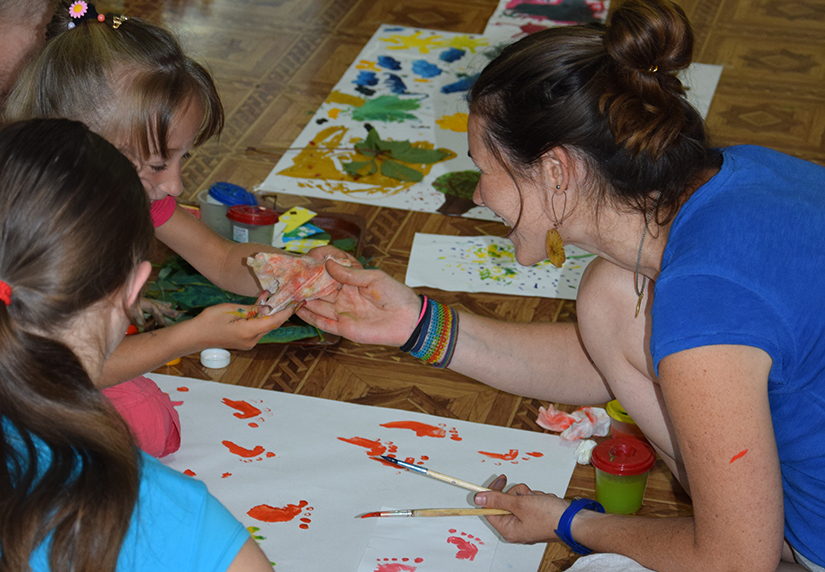 ChildFund is supporting projects for children with disabilities in Vyshhorod. The snacks were made by children who attended a catering training. © Yellow-Blue Wings
ChildFund is supporting projects for children with disabilities in Vyshhorod. The snacks were made by children who attended a catering training. © Yellow-Blue Wings
Finally, we went to the special school “Hope” in Vyshhorod and spoke to children, parents and teachers. Including parents in the work with the children is an important component of this school´s concept and approach. A German corporate foundation, the Lipoid Stiftung, is funding most of the activities ChildFund is doing at this school.
We finished this last day by visiting the office of ChildWellbeing Fund, ChildFund´s oldest partner organization in Ukraine. We learned a lot about its current activities, and were encouraged to hear that previous projects – funded by ChildFund – are still going and are doing a lot of useful work for children and youth.








